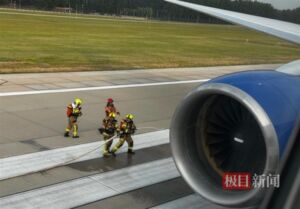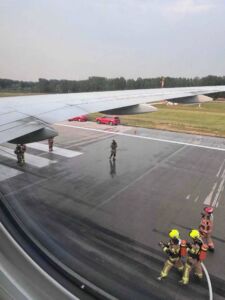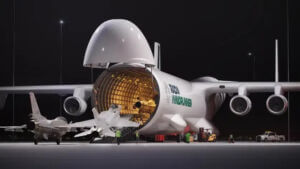These are the stories for today...
Of note, aside from a couple of aircraft incidents, we have stories regarding new safety regulations for SpaceX "Starship" launches, the USAF looking into an "Enormous Cargo Plane" and a story shared by Bill Hutfilz regarding retired USAF Fire Chef Ashontay Owens and his "The Crimson Melt", "where firehouse camaraderie meets gourmet grilled cheese." If you're ever in Moore, Oklahoma, look him up!
Have a safe day!
Tom
Small plane makes rough landing at Lincoln airport
By 10/11 NOW
LINCOLN, Neb. (KOLN) - A small airplane  made a rough landing at the Lincoln Airport on Tuesday afternoon, prompting a response from emergency crews.
made a rough landing at the Lincoln Airport on Tuesday afternoon, prompting a response from emergency crews.
The aircraft emergency was reported at 1:08 p.m. An airport spokesperson said the plane’s landing gear had collapsed. The cause of the failure is under investigation.
According to the Lincoln Airport, six people were on board the Pilatus aircraft at the time, however no injuries were reported.
A 10/11 reporter at the scene said there was some damage to the plane, with the nose of the plane pointing towards the ground.
The runway is currently closed so an emergency team can assess the damage and move the plane out of the way.
https://www.1011now.com/2025/05/27/small-plane-makes-rough-landing-lincoln-airport/
A United Airlines plane made an emergency stop during takeoff at Beijing Capital Airport. The airline said it was a mechanical failure.
Author: Upstream News, Jimu News
On the 26th, many netizens posted that at  about 5 pm that day, when they were on United Airlines flight UA889 from Beijing Capital International Airport to San Francisco, the plane suddenly encountered a fault and stopped in an emergency while accelerating for takeoff. The fire brigade quickly arrived at the scene to deal with it. All the people on board were safe and the flight was canceled. On the 27th, a passenger on the flight told Upstream News that he saw a flash of fire in the right engine of the plane. United Airlines said the flight was canceled due to a mechanical failure, and the Beijing Capital International Airport Fire Rescue Management Center said that various data are currently being collected.
about 5 pm that day, when they were on United Airlines flight UA889 from Beijing Capital International Airport to San Francisco, the plane suddenly encountered a fault and stopped in an emergency while accelerating for takeoff. The fire brigade quickly arrived at the scene to deal with it. All the people on board were safe and the flight was canceled. On the 27th, a passenger on the flight told Upstream News that he saw a flash of fire in the right engine of the plane. United Airlines said the flight was canceled due to a mechanical failure, and the Beijing Capital International Airport Fire Rescue Management Center said that various data are currently being collected.
"Yesterday (26th) around 5pm, everything was normal when we boarded the plane," Ms. Han, a passenger on United Airlines flight UA889, told Upstream News on May 27. When the plane entered the runway and accelerated to take off, "it felt like the acceleration was only about 10 seconds, and then the plane began to slow down. It felt like it was forced to slow down, and the panels on the wings were also opened. It felt like the plane was not very stable, and it shook a few times on the runway before it stopped." Then, Ms. Han saw the fire truck arrive and the firefighters sprayed something on the plane. "It may be to cool it down. It may be water. There is liquid on the ground." Ms. Han told reporters that the captain said on the radio that this was a normal procedure, probably to comfort the passengers. More than an hour after the plane stopped, Ms. Han and all the passengers on board got off the plane and returned to the terminal by shuttle bus. "United Airlines provided one night's accommodation, so I had to change my trip to tomorrow (28th), and I need to take one more day off." 
"The plane entered the runway and began to accelerate. About 10 seconds later, I heard a 'bang' and saw a ball of fire coming out of the wing. A few seconds later, the plane braked to a stop and firefighters came and sprayed water to cool it down." On May 27, Matt, another passenger on United Airlines flight UA889, told Upstream News reporters that he was sitting by the window behind the right engine of the plane and saw a flash of fire from the right engine. The cancellation of this flight also affected his itinerary. He changed to today's (27th) flight, and United Airlines provided them with a $175 flight voucher.
"From what we can see here, it shows a mechanical failure." On May 27, a reporter from Upstream News called United Airlines as a passenger. The customer service staff said that the flight status displayed on the official website showed a mechanical failure. Regarding the problem that some netizens claimed was "engine on fire", the staff member said that the specific situation was unclear. "Under normal circumstances, if a flight is cancelled, (passengers) will be given a flight protection."
As for what specific malfunction occurred on United Airlines flight UA889, on May 27, a reporter from Upstream News called the Beijing Capital International Airport Fire Rescue Management Center as a passenger. The staff who answered the call confirmed that the police were dispatched at the time and said that various data are now being collected.
According to the "Travel.com", the aircraft used in this flight is a Boeing 777-222 (ER) wide-body aircraft with an age of 27.6 years. On May 27, United Airlines customer service said that flight UA889 on the 26th could not take off due to technical failure, and the same flight on the 27th was also cancelled. The above passenger told reporters that he had been arranged to take another flight to San Francisco on the 27th.
Original title: "A United Airlines passenger plane at Beijing Capital Airport braked urgently during takeoff, the airline said it was a mechanical failure"
https://export.shobserver.com/baijiahao/html/917848.html
FAA Approves SpaceX Starship Return to Flight With New Safety Considerations
Agency nearly doubles the aircraft hazard area after the massive rocket exploded on back-to-back test flights in January and March.
Jack Daleo
After exploding on back-to-back  test flights in January and March, SpaceX’s massive Starship rocket has been greenlit for a ninth launch—with new safety considerations.
test flights in January and March, SpaceX’s massive Starship rocket has been greenlit for a ninth launch—with new safety considerations.
The FAA on Thursday announced it awarded Starship a return-to-flight determination authorizing Flight 9, which SpaceX CEO Elon Musk predicted would lift off this week. The agency will nearly double the previous flight’s aircraft hazard area (AHA) based on SpaceX’s analysis of that mission, it said in a statement.
Earlier this month, the regulator issued two environmental assessments for Flight 9—one updating airspace closures, and another greenlighting 25 Starship launches per year from SpaceX’s Starbase facility in Texas. Neither assessment turned up safety or environmental concerns, the FAA said.
“The FAA conducted a comprehensive safety review of the SpaceX Starship Flight 8 mishap and determined that the company has satisfactorily addressed the causes of the mishap, and therefore, the Starship vehicle can return to flight,” the agency said. “When making this determination, the FAA considers several factors, including but not limited to, the nature of the mishap, the performance of vehicles safety-critical systems, and the generation of unplanned debris.”
Starship failed to reach orbit on its previous two attempts, instead exploding and prompting the FAA to alert nearby aircraft of falling debris. Each incident disrupted air travel, but there were no reported injuries and minimal property damage on the ground. The FAA told FLYING that 171 departures were delayed by an average of 28 minutes while a debris response area was active during Flight 8. Twenty-eight flights were diverted, and another 40 were placed in holding patterns.
SpaceX submitted its Flight 8 mishap report on May 13, and the investigation remains open, an FAA spokesperson told FLYING. Notably, the agency signed off on that mission before SpaceX closed its investigation into Flight 7.
After back-to-back mishaps, SpaceX was required to update its flight safety analysis, which covers population exposure risk, the probability of another explosion, and the behavior and sprawl of debris. Based on that analysis—and its planned reuse of a previously launched Super Heavy booster—the FAA expanded its aircraft hazard area from about 885 nm to 1,600 nm. The AHA extends from Florida through Texas and also covers the Bahamas and Turks and Caicos islands.
“The FAA is in close contact and collaboration with the United Kingdom, Turks [and] Caicos Islands, Bahamas, Mexico, and Cuba as the agency continues to monitor SpaceX’s compliance with all public safety and other regulatory requirements,” it said.
SpaceX has yet to share Flight 9 details on its website or social media, as it typically does before a Starship launch. But chances are the company will again attempt to snare the reusable Super Heavy booster from the sky using a pair of giant metal chopsticks at Starbase. It achieved the maneuver for the first time in history on Flight 5 in October and has tried to replicate it on every flight since, succeeding on each of the past two attempts.
Reusability is a key selling point for Starship and Super Heavy, as it can significantly lower launch costs. Catching Starship itself is another near-term goal for SpaceX, and it could use the upcoming flight to gear up for that challenge. Flight 6, for example, included a variety of tests designed to collect data on the rocket as it headed for splashdown.
Air Force Eyes Enormous Cargo Plane
With its 8,000-cubic-meter cargo hold, the WindRunner has attracted the attention of the Air Force.
Russ Niles
The Air Force has given a lift to an audacious program to build the world’s biggest  airplane. USAF reasons that an airplane big enough to carry wind turbine blades and land on gravel runways might have military applications, so it’s entered into a Cooperative Research and Development Agreement (CRADA) to advance the development of the Radia WindRunner. “By leveraging the unique design and capabilities of the WindRunner, we can together explore innovative solutions for transporting outsized and high-volume cargo, enhancing the DoD’s ability to respond to global challenges,” said Mark Lundstrom, Radia Founder and CEO.
airplane. USAF reasons that an airplane big enough to carry wind turbine blades and land on gravel runways might have military applications, so it’s entered into a Cooperative Research and Development Agreement (CRADA) to advance the development of the Radia WindRunner. “By leveraging the unique design and capabilities of the WindRunner, we can together explore innovative solutions for transporting outsized and high-volume cargo, enhancing the DoD’s ability to respond to global challenges,” said Mark Lundstrom, Radia Founder and CEO.
WindRunner was conceived as a solution to a problem far removed from the logistical needs of the military. Wind turbines are restricted in size (and therefore efficiency) because of transportation limitations. Radia figured that there are plenty of places that get lots of wind that would accommodate an unpaved runway big enough to launch and recover a giant airplane, so it designed the WindRunner specifically to carry a 340-foot turbine blade. The result is an 8,000-cubic-meter cargo hold with a nose that flips up out of the way. The Air Force came calling and suddenly the rather specialized market for the WindRunner expanded.
“The WindRunner allows the world’s biggest things to be delivered to the hardest-to-reach locations. This collaboration demonstrates how commercial capabilities may help to support U.S. national defense by integrating with and addressing military needs,” Lundstrom said. The joint research project will look at the full gamut of integrating the huge airplane into Air Force operations from the types of loads it could carry to how to use it in military actions. There will be a lot of attention paid to its airfield needs, including the services and equipment that will be needed to accommodate the enormous airplane.
https://avweb.com/aviation-news/air-force-eyes-enormous-cargo-plane/?oly_enc_id=3681J3205156A2X
Fight fires, flip sandwiches: Veteran's unique take on Moore's dining experience
Explore the story of The Crimson Melt, where firehouse camaraderie meets gourmet grilled cheese. Led by an Air Force Veteran, their mission extends beyond just filling bellies in Moore.
Monday, May 26th 2025, 7:53 am
By: Kylee Dedmon
MOORE, OK -
On Monday, KWTV News 9 highlighted a  local Veteran-Owned business to share their story and their mission to help their community.
local Veteran-Owned business to share their story and their mission to help their community.
Owner of The Crimson Melt in Moore, Ashontay Owens is a United States Air Force Veteran. Owens served as a firefighter in the Air Force for 20 years and retired as a fire chief in 2021.
Owens has been deployed six times and been deployed eight times, but each location has something similar in a location you don't often think about, the kitchen.
Owens started The Crimson Melt, a gourmet grilled cheese restaurant almost two years ago, all because of bread, butter, and cheese became his comfort meal since he said that's something that was always in the fridge at all firehouses.
“It’s been a joy trying to find what my real passion was, and that was really pouring into others, serving, and cooking. I like to eat, I’m a fat kid at heart, so I figured why not tell the firefighting story of how we break bread around the shift dinner table and share that with our customers," Owens said.
The Crimson Melt is a first-responder themed restaurant, driven by a mission to recognize and support our nation's Veterans.
"So the Crimson Melt idea is: come dine in a firehouse, whatever happened out there, leave it out there, if you had a bad day it’s okay we are brothers and sisters in here, we’ll take care of you, we’ll feed you, we’ll do everything we need to,” Owens said.
Owens tells me shift dinner is something that's symbolic within all firehouses. Coming together at the table to break bread, decompress, and enjoy each other's company. He said he wanted to bring that unity and solidarity to everybody’s table.
“I wanted to do something for two reasons, one: I wanted to tell the Air Force Firefighting story, I wanted to tell the DOD Firefighting story, and let everybody understand and know the differences and hey the Department of Defense also has firefighters, but it’s also two-fold here," Owens said. "The other part of that is that I wanted to really shine a light on mental health. And as you know, firefighters, cops, medics we all respond to emergency scenes and sometimes those scenes don’t work out in our favor, and a lot of the times it can be very, very traumatic and that trauma will stick with you for a little while, especially after you experience things for a while."
One of the first things you see when you walk into The Crimson Melt is the Wall of Heroes. That wall is covered in first-responder patches where they have come in to eat, share their stories, and hang their patch on the wall.
"I really, really have an innate passion to want to save life and to pour into others and to give to others and to make sure others can come home safe, not just firefighters but everybody around us, because it is hard when you are dealing with some of these calls," Owens said.
Owens also founded the Folds to the Flame foundation, a mission fueled by honor and county focused on first-responder suicide awareness, prevention, and postvention.
Along with grilled cheeses, The Crimson Melt also serves luxury milkshakes.
The Crimson Melt will mark its second-year anniversary this June.
NTSB Prelim: Piper PA32RT
Video Showed That During The Takeoff, The Nose Baggage Door Was Open
Location: Yulee, FL Accident Number: ERA25FA201
Date & Time: May 10, 2025, 09:35 Local Registration: N30689
Aircraft: Piper PA32RT Injuries: 1 Fatal
Flight Conducted Under: Part 91: General aviation - Personal
On May 10, 2025, about 0935 eastern daylight time, a Piper PA-32RT-300, N30689, was destroyed when it was involved in an accident near Yulee, Florida. The private pilot was fatally injured. The airplane was operated as a Title 14 Code of Federal Regulations Part 91 personal flight.
The pilot’s wife reported that the purpose of the flight was for the pilot to reposition the airplane from Nassau Airport (83FL), Yulee, Florida to Fernandina Beach Municipal Airport (FHB), Fernandina Beach, Florida, where they would wait for approaching thunderstorms to pass through the area before continuing on to Tennessee. She reported that earlier that morning, the pilot had dropped her and their dogs off at FHB before driving back to 83FL where he planned to finish loading the airplane for their trip and make the short flight to FHB. Review of video captured by a motion-activated surveillance camera mounted on a hangar near the end of runway 12 at 83FL showed that the airplane taxied toward runway 12 and began a back taxi down the runway and out of the video frame. During the taxi the airplane’s nose baggage door was closed. As the video continued, the airplane re-entered the frame on a takeoff roll at 0934. The video showed that during the takeoff, the nose baggage door was open. The door stayed open until the airplane became airborne and exited the video frame. Following the accident, a sweep of the usable portion of runway 12 found a case of aviation oil about 100 ft from the beginning of the runway and to the right of centerline. A bag of dog food was also found about 440 ft from the beginning of the runway and to the right of centerline. Review of surveillance video from a residence that was located about 550 ft north of the departure end of the runway showed the airplane in a steep left wing low descent prior to impacting a tree and the ground about 10 seconds after departing 83FL.
The wreckage was examined at the accident. The initial impact point was identified as a broken branch about 40 ft up a tree. A crater in the ground was identified about 24 feet away from the tree, and the wreckage came to rest upright about 15 ft from the crater, on a heading of 264° magnetic. The calculated angle of descent between the initial tree impact and the crater was about 50°. An 84-inch-long outboard portion of the left wing was impact-separated and remained near the crater with the left aileron attached.
The cockpit and a majority of the fuselage were consumed by postimpact fire. The left flap, right wing, rudder, vertical stabilizer, and a majority of the stabilator and stabilator trim were also consumed by the postimpact fire. Aileron flight control continuity was confirmed from the aileron bellcranks to the flight control attachment points in the cockpit. Rudder flight control continuity was confirmed from the rudder control drum to the rudder pedals in the cockpit.
Stabilator control continuity was confirmed from the stabilator control bellcrank to the lower portion of the cockpit control. The stabilator trim actuator was measured and equated to a trim setting halfway between full nose down and neutral. The three-blade propeller remained attached to the engine crankshaft flange. The propeller blades exhibited aft bending and chordwise scratching. Engine crankshaft and valvetrain continuity was established when the propeller was rotated 720°. Thumb suction and compression were observed on all cylinders. The vacuum pump remained attached to the engine accessory case; the drive gear and carbon veins all remained intact. The left standard magneto and right electronic magneto were removed and exhibited thermal damage. The fuel pump exhibited impact and thermal damage. The fuel injector assembly was impact separated and exhibited thermal damage. The sparkplugs were removed and exhibited normal wear and coloration consistent with normal engine operation when compared to the Champion Aviation Check-A-Plug AV-27 chart. The fuel injector nozzles were removed and were free of debris.
The postimpact fire consumed most of the airplane’s fuel system. Both main wing fuel tanks were breached and exhibited thermal damage.
The wreckage was retained for further examination.
The pilot’s wife reported that several weeks before the accident, she and the pilot had flown from Clearwater Air Park (CLW), Clearwater, FL to 83FL, a flight that was about 1 hour long. She reported that they had fully fueled the airplane prior to that flight and that the accident flight was the first flight since. She also described that 83FL did not have fuel services and they did not add any fuel to the airplane after the flight from CLW to 83FL. Preliminary review of the Piper PA-32RT-300 Pilot Operating Handbook showed the airplane had an endurance between 5 and 7 hours depending on the power setting used.
Preliminary review of weather radar data showed a line of intense precipitation echoes moving through the area at the time of the accident. A weather station at FHB, which was located about 3 nautical miles east of the accident site, reported at 0935 that the wind was from 180° true at 5 knots, 10 statute miles of visibility, and scattered clouds at 2,300 ft above ground level with thunderstorms in the vicinity and lightning distant southwest through north. The same station reported at 0955 wind from 320° at 13 knots gusting to 20 knots, 2 statute miles of visibility in heavy rain and thunderstorms, overcast clouds at 2,100 ft above ground level, and lightning in all quadrants.
FMI: www.ntsb.gov

Today in History
57 Years ago today: On 28 May 1968 Garuda Indonesia Airways flight GA892, a Convair CV-990, crashed after takeoff from Mumbai, India, killing all 29 occupants. Several villagers at Bilalpada were struck by debris. One of them was killed.
| Date: | Tuesday 28 May 1968 |
| Time: | 02:46 |
| Type: | Convair CV-990-30A-5 Coronado |
| Owner/operator: | Garuda Indonesia Airways |
| Registration: | PK-GJA |
| MSN: | 30-10-3 |
| Engine model: | General Electric CJ805-23 |
| Fatalities: | Fatalities: 29 / Occupants: 29 |
| Other fatalities: | 1 |
| Aircraft damage: | Destroyed, written off |
| Category: | Accident |
| Location: | 37 km N of Mumbai Airport (BOM) - India |
| Phase: | En route |
| Nature: | Passenger - Scheduled |
| Departure airport: | Bombay-Santacruz Airport (BOM/VABB) |
| Destination airport: | Karachi International Airport (KHI/OPKC) |
Narrative:
Garuda Indonesia Airways flight GA892, a Convair CV-990, crashed after takeoff from Mumbai, India, killing all 29 occupants. Several villagers at Bilalpada were struck by debris. One of them was killed.
The airplane operated on an international service from Jakarta, Indonesia to Amsterdam (AMS), the Netherlands with en route stops at Bombay, Karachi, Cairo and Rome.
The aircraft crashed in a nearly vertical attitude, some 14 minutes after takeoff.
